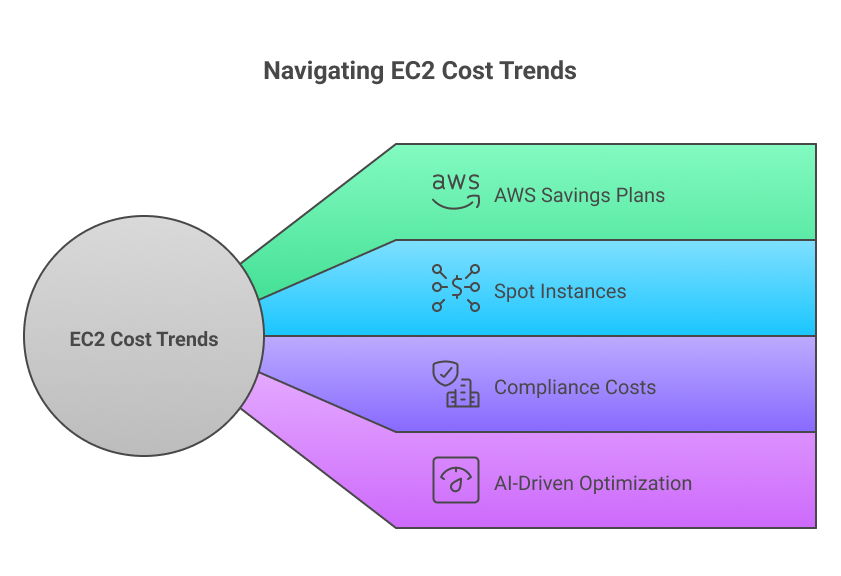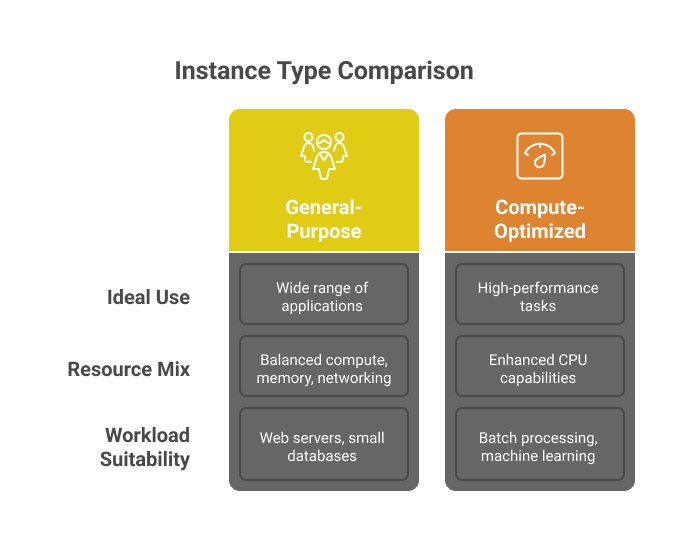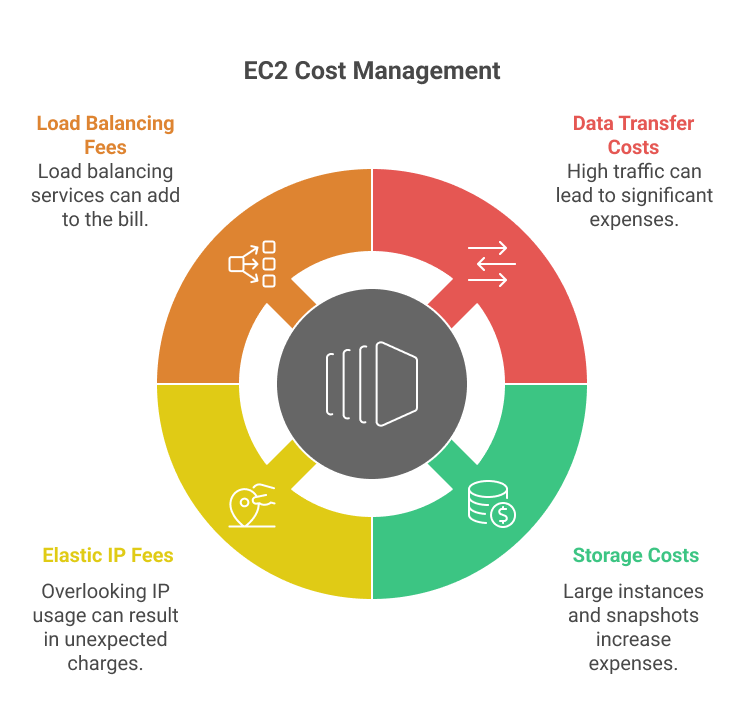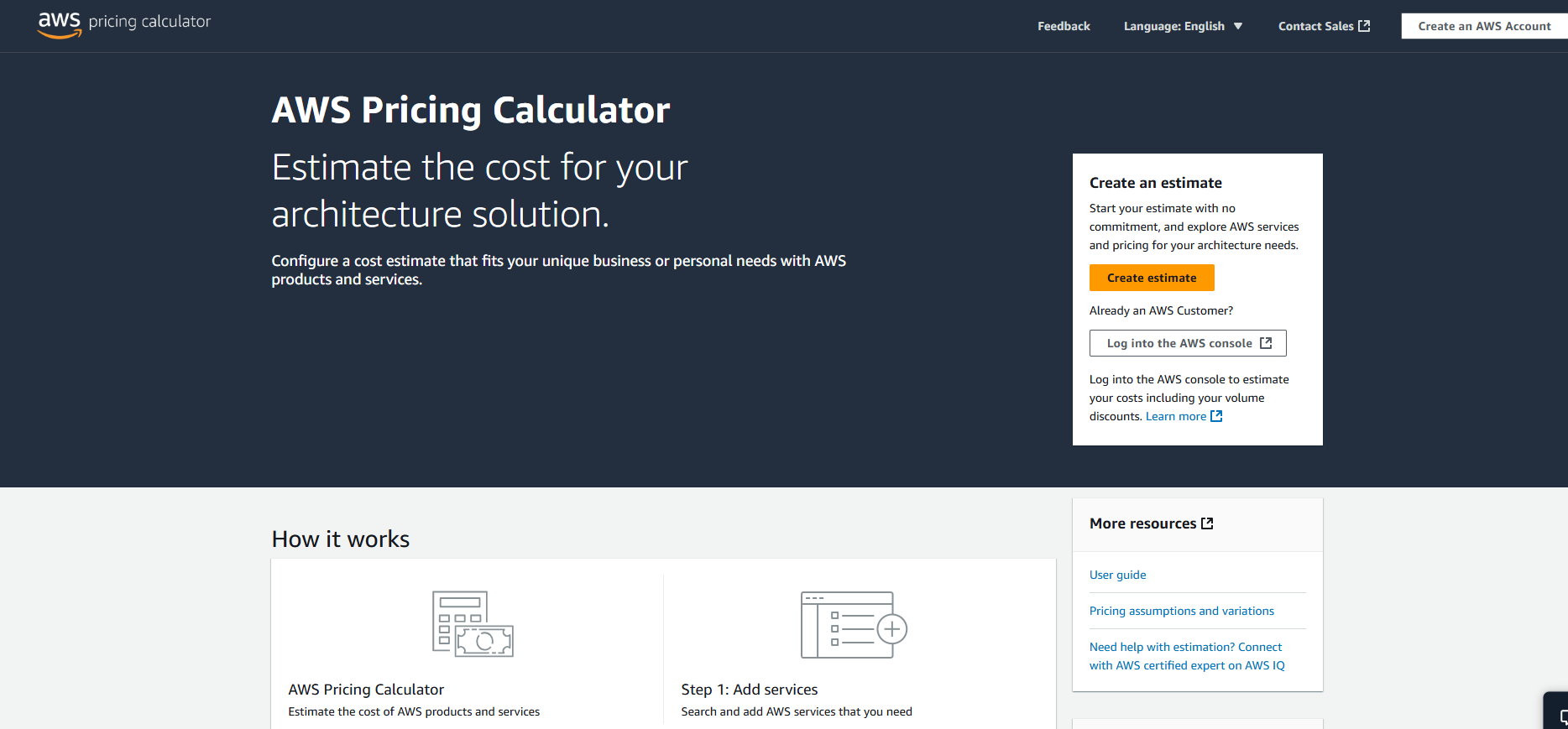Published
- 18 min read
AWS EC2 Pricing 2025: EC2 Costs and Instance Costs Explained

Key Highlights
- Understanding AWS EC2 pricing in 2025 is essential for effective cloud budgeting and cost management.
- The guide highlights diverse pricing models, including on-demand, reserved, and spot instances, allowing users to select the best option for their workload.
- Key changes in pricing and increased transparency help users avoid hidden fees and extra charges.
- By leveraging tools like Amazon’s pricing calculator and Kuberns cost estimator, users can accurately forecast costs and optimize spend.
- Implementing cost optimization strategies such as instance right-sizing and automated savings will lead to significant long-term cost savings.
- Cloud users can achieve better performance and efficiency by selecting the right instance types based on specific workloads and usage patterns.
Introduction
Navigating the landscape of cloud computing can often feel overwhelming, especially with the various factors that influence pricing. Understanding AWS EC2 pricing is essential for businesses looking to maximize their cloud investment. With a range of instance types, pricing models, and additional fees, it’s crucial to stay informed about the current trends and changes shaping costs in 2025. Utilizing resources like the pricing calculator and Kuberns takes it further by running workloads on its own AWS backbone, leveraging bulk-reserved infrastructure, AI-powered workload optimization, and transparent pricing to deliver up to 40% savings on AWS EC2 costs.
Overview of AWS EC2 Pricing in 2025
In 2025, AWS EC2 pricing reflects a landscape that prioritizes flexibility and cost efficiency. The introduction of savings plans and smarter instance types provides users with options tailored to their unique workloads. Understanding the pricing models, on-demand, reserved, and spot instances allows businesses to optimize their cloud expenditure effectively. Additionally, tools like the AWS Pricing Calculator and Kuberns.com offer valuable insights for cost estimation and management. Kuberns simplifies pricing by bundling AWS infra savings into one transparent model, no lock-in.
Latest Trends Influencing EC2 Costs
 Several emerging patterns are shaping the pricing landscape for EC2 instances:
Several emerging patterns are shaping the pricing landscape for EC2 instances:
- Increased adoption of AWS Savings Plans enables businesses to realize significant cost reductions through longer-term commitments across diverse instance types.
- The rise of unpredictable workloads has elevated the importance of dynamic pricing strategies like Spot Instances, helping organizations capitalize on fluctuating demand.
- As compliance requirements evolve, businesses must also budget for associated costs tied to maintaining security and performance standards.
Explore how AI-driven optimization is redefining cloud cost management in this blog: How AI Optimization Makes IT Cloud Solutions More Cost-Effective. It explains how Kuberns leverages AI to automatically shift workloads into the most cost-effective models whether that’s Reserved Instances, Spot Instances, or even different regions to help companies cut AWS expenses by up to 40% while preserving performance
Key Changes from Previous Years
Recent years have shown significant shifts in AWS EC2 pricing strategies. Enhanced options like savings plans and flexible instance types are designed to cater to diverse workloads while reducing costs. The introduction of automatic scaling and more granular pricing models, such as usage-based billing, has further enabled users to optimize expenses based on specific workloads.
Why Pricing Transparency Matters for Cloud Users
Understanding the true costs associated with cloud services is essential for users navigating AWS EC2. Pricing transparency empowers customers to make informed decisions, allowing for effective cost management and avoiding unexpected charges. By clearly detailing fees associated with instance types, data transfer, and additional services, users can leverage platforms like Kuberns for accurate cost comparisons. This level of transparency fosters trust and encourages businesses to explore optimal AWS pricing options, including savings plans and reserved instances, ultimately leading to substantial savings over time.
Understanding AWS EC2 Instance Types
Determining the right Amazon Elastic Compute Cloud (EC2) instance type is essential for optimizing performance and cost. Understanding the various instance categories : general purpose, compute optimized, memory optimized, and storage optimized enables businesses to align their compute capacity with specific workloads. Each instance family boasts unique capabilities suited for different applications, whether it involves batch processing, cloud computing, or advanced machine learning tasks. Effectively utilizing tools like the AWS Pricing Calculator or Kuberns Pricing Calculator (recommended) can simplify the decision-making process, ensuring that users select the best option for their operational needs.
General Purpose vs. Compute Optimized Instances
 General-purpose instances are versatile and ideal for a wide range of applications, providing a balanced mix of compute, memory, and networking resources. They’re perfect for workloads with varying demand, like web servers and small databases. On the other hand, compute-optimized instances excel in high-performance tasks, such as batch processing and machine learning, due to their enhanced CPU capabilities. Choosing between the two hinges on your specific workload requirements. For deeper insights, Kuberns Pricing Calculator shows how each instance type compares in real-world workloads helping you pick the right option while saving up to 40% over direct AWS pricing. For deeper insights and comparisons, don’t forget to check out how AI-driven optimisation embeds cost efficiency into workloads automatically in the Kuberns blog: How AI Optimisation Makes IT Cloud Solutions More Cost-Effective.
General-purpose instances are versatile and ideal for a wide range of applications, providing a balanced mix of compute, memory, and networking resources. They’re perfect for workloads with varying demand, like web servers and small databases. On the other hand, compute-optimized instances excel in high-performance tasks, such as batch processing and machine learning, due to their enhanced CPU capabilities. Choosing between the two hinges on your specific workload requirements. For deeper insights, Kuberns Pricing Calculator shows how each instance type compares in real-world workloads helping you pick the right option while saving up to 40% over direct AWS pricing. For deeper insights and comparisons, don’t forget to check out how AI-driven optimisation embeds cost efficiency into workloads automatically in the Kuberns blog: How AI Optimisation Makes IT Cloud Solutions More Cost-Effective.
Memory Optimized and Storage Optimized Instances
Memory optimized instances are designed to deliver high performance for workloads that require substantial memory allocation, such as in-memory databases and real-time big data analytics. These instance types excel in applications like Amazon RDS and Amazon Redshift, providing the necessary compute capacity to handle large datasets efficiently. Conversely, storage optimized instances cater to workloads demanding high disk throughput and low latency. Ideal for data warehousing and distributed file systems, they enhance storage performance, making them a reliable choice for diverse applications.
Choosing the Right Instance for Your Workload
Selecting the most suitable instance for your specific workload can significantly impact performance and cost management. Consider the nature of your applications whether they require high compute capacity, large memory resources, or a balance of both. AWS offers various instance types, each catering to different needs, such as general purpose or compute-optimized options. Utilize the Kuberns Pricing Calculator for tailored cost estimates across AWS, GCP, and Railway making it clear how much you can save by deploying on Kuberns instead of raw AWS.
Core EC2 Pricing Models Explained
The core pricing models for EC2 provide flexibility and cost-effectiveness tailored to various workloads. On-demand instances allow users to scale compute capacity without long-term commitments, catering perfectly to unpredictable workloads. In contrast, reserved instances offer significant savings for those who can commit to a term. Spot instances provide access to unused EC2 capacity at dynamic prices, ensuring cost management is optimized.
On-Demand Instances: Flexibility and Cost
On-demand instances from AWS offer unmatched flexibility, allowing users to scale compute capacity according to specific workload requirements. Ideal for unpredictable workloads, they provide the freedom to launch instances on short notice without long-term commitments. This payment model is particularly beneficial for projects with fluctuating demands, ensuring you only pay for what you use. For tailored cost estimates across AWS, GCP, Railway, and more, try the Kuberns Pricing Calculator which is perfect for comparing options side by side.
Reserved Instances: Long-term Savings
Transitioning to Reserved Instances offers substantial long-term savings for businesses leveraging AWS. By committing to a specified term, users can benefit from reduced hourly prices in comparison to on-demand instances, aligning costs with predictable workloads. This pricing model is particularly advantageous for sustained compute capacity needs, allowing for optimal resource allocation. For more detailed insights on maximizing savings with Reserved Instances, check out the tools at Kuberns. Utilizing such resources can significantly enhance your cost management strategies and ensure compliance with various financial planning requirements.
Spot Instances: Dynamic Pricing for Discounted Compute
Spot instances offer a cost-effective alternative for users willing to take advantage of Amazon Elastic Compute Cloud’s dynamic pricing. Ideal for unpredictable workloads, they operate on spare capacity within AWS, allowing significant savings compared to on-demand pricing. Utilizing spot pricing requires flexibility, as instances can be interrupted, but with proper management, such as integrating with AWS Auto Scaling, users can optimize their compute capacity efficiently.
Comparing EC2 Instance Costs and Specifications
Understanding the variety of EC2 instance types is essential for evaluating costs and specifications effectively. Prices differ based on the chosen instance family, such as compute-optimized or memory-optimized types, influenced by factors like availability zones and specific workloads. For those seeking an in-depth analysis, examining tools like Kuberns can streamline cost comparisons, providing insights into performance and value. Utilizing these resources ensures that decisions align with operational demands while optimizing savings and enhancing overall cloud cost management.
Price Differences by Instance Type
Variations in EC2 instance types lead to significant differences in pricing, shaped by intended use cases and specifications. General purpose instances provide a balanced mix of compute, memory, and networking resources, making them cost-effective for many applications. In contrast, compute-optimized, memory-optimized, and storage-optimized instances cater to specific needs, often reflecting higher hourly prices due to enhanced performance capabilities.
Comparing Server Performance and Value
Evaluating server performance involves analyzing compute capacity and understanding how different instance types align with your workload requirements. General-purpose instances may suffice for standard tasks, while compute-optimized alternatives shine in data-intensive applications. Value is derived not only from performance but also from cost-effectiveness, as spot instances can dramatically reduce expenses especially for unpredictable workloads.
Where to Find Reliable EC2 Cost Comparisons
Evaluating EC2 pricing requires accessible and accurate resources. Kuberns.com stands out, offering detailed cost comparisons and analyses specifically tailored for AWS services. Their platform not only highlights variations in instance types but also provides insights into pricing models, ensuring clarity in your decision-making process.
Additional Charges and Hidden Fees with EC2
 Understanding the potential additional charges associated with EC2 is crucial for effective cost management. Data transfer costs can add up quickly, especially if workloads involve significant inbound or outbound traffic. Storage costs for Amazon EBS volumes and snapshots also contribute to the expense, particularly when using larger instances. Oversights regarding elastic IP addresses or load balancing can lead to unexpected fees. To prevent surprises, utilizing tools like the AWS Pricing Calculator or exploring Kuberns Pricing Calculator can provide clarity on your financial forecast.
Understanding the potential additional charges associated with EC2 is crucial for effective cost management. Data transfer costs can add up quickly, especially if workloads involve significant inbound or outbound traffic. Storage costs for Amazon EBS volumes and snapshots also contribute to the expense, particularly when using larger instances. Oversights regarding elastic IP addresses or load balancing can lead to unexpected fees. To prevent surprises, utilizing tools like the AWS Pricing Calculator or exploring Kuberns Pricing Calculator can provide clarity on your financial forecast.
Data Transfer Costs
Understanding data transfer costs is crucial for managing AWS EC2 expenses. Charges typically stem from outbound data transferring from EC2 instances to the internet or other AWS services, which can quickly add up, especially during peak usage. Keeping an eye on data transfer rates and leveraging AWS Pricing Calculator can provide better visibility and control over expenses. For an all-in-one tool that helps you model these costs across AWS, GCP, Railway, and more, try the Kuberns Pricing Calculator for streamlined, transparent budgeting.
Storage Costs (EBS & Snapshots)
Understanding storage costs associated with Amazon EBS and snapshots can significantly impact your budget. Each snapshot taken incurs charges based on the amount of data stored, while EBS volumes have specific pricing based on type and performance. Regularly assessing your storage use through tools such as the AWS Pricing Calculator can lead to substantial cost savings. Moreover, incorporating Kubern’s cost estimator can help optimize your storage expenses, ensuring you’re not overspending on unused capacity and efficiently managing your cloud costs.
Elastic IP, Load Balancing, and Other Extras
Elastic IP addresses provide a static solution for cloud computing, ensuring users maintain a consistent endpoint even when instances are stopped or restarted. Load balancing optimizes application availability by distributing incoming traffic across multiple instances, enhancing performance and reliability. Additionally, costs associated with data transfer and other AWS services can accumulate. The Kuberns Pricing Calculator helps you model these extras to avoid surprises and manage your cloud spend effectively.
Tools for Calculating and Estimating EC2 Expenses
Utilizing effective tools for calculating and estimating EC2 expenses can significantly enhance cost management. The AWS Pricing Calculator is a fantastic starting point, allowing users to create custom cost estimates based on specific workloads and instance types. For a user-friendly alternative, consider Kuberns Cost Estimator, which simplifies the budgeting process by providing real-time insights into potential savings. Both platforms help monitor instance usage and optimize spending, ensuring that you remain within your budget while maximizing the benefits of Amazon Elastic Compute Cloud.
AWS Pricing Calculator Walkthrough
 Navigating the AWS Pricing Calculator can be straightforward and beneficial for estimating your cloud costs. Start by selecting the appropriate EC2 instance types based on your specific workloads. Input criteria like the number of instances, region, and expected usage patterns. The tool offers insightful breakdowns, reflecting both on-demand and reserved instances, which helps in identifying potential savings.
Navigating the AWS Pricing Calculator can be straightforward and beneficial for estimating your cloud costs. Start by selecting the appropriate EC2 instance types based on your specific workloads. Input criteria like the number of instances, region, and expected usage patterns. The tool offers insightful breakdowns, reflecting both on-demand and reserved instances, which helps in identifying potential savings.
Using Kuberns Cost Estimator for Easy Calculations
 Utilizing the Kuberns cost estimator simplifies the process of calculating your AWS EC2 expenses. This intuitive tool allows you to input specific workload parameters and gain insights into potential costs, including savings options like reserved instances and spot instances. By optimizing your instance usage alongside budget considerations, you can effectively manage your cloud spending. Plus, with detailed reporting, Kuberns helps track your cost management over time, ensuring you stay within budget while leveraging AWS services efficiently. Explore more at kuberns.com for a seamless calculation experience.
Utilizing the Kuberns cost estimator simplifies the process of calculating your AWS EC2 expenses. This intuitive tool allows you to input specific workload parameters and gain insights into potential costs, including savings options like reserved instances and spot instances. By optimizing your instance usage alongside budget considerations, you can effectively manage your cloud spending. Plus, with detailed reporting, Kuberns helps track your cost management over time, ensuring you stay within budget while leveraging AWS services efficiently. Explore more at kuberns.com for a seamless calculation experience.
Budgeting Your Monthly EC2 Spend
Establishing a clear budget for your monthly EC2 spend is essential for effective cost management. Start by tracking instance usage and understanding the differences between pricing models, such as on-demand and reserved instances. Utilizing tools like the AWS Pricing Calculator can help you estimate costs based on your specific workloads and instance types.
Cost Optimization Strategies for EC2 in 2025
Effective cost optimization strategies for EC2 in 2025 focus on balancing performance with savings. Leveraging AWS Savings Plans and Reserved Instances can provide significant savings on your long-term compute requirements. Additionally, using Spot Instances for unpredictable workloads can help reduce spending dramatically. Implementing auto-scaling ensures that instances are only running when needed, while tools like the AWS Pricing Calculator and the Kuberns Cost Estimator can assist in budgeting and fine-tuning your EC2 spend. Embracing these strategies positions your business for enhanced efficiency without sacrificing performance.
Automated Savings and Instance Right-Sizing
Maximizing savings in cloud environments often hinges on automated savings and instance right-sizing strategies. Tools like AWS Auto Scaling enable users to adjust the number of instances based on demand, ensuring optimal compute capacity without overspending. By utilizing these features, businesses can significantly reduce costs associated with unused or underutilized resources. Additionally, Platforms like Kuberns take it further: Learn how AI-driven optimization dynamically reallocates workloads to the most cost-efficient options in the blog How AI Optimisation Makes IT Cloud Solutions More Cost-Effective.
Leveraging Reserved and Spot Instances Effectively
Reserved and spot instances can significantly reduce costs when managed wisely. Committing to reserved instances allows businesses to benefit from consistent pricing for compute capacity over the long term, optimizing budgeting and ensuring resources are available for critical workloads. On the other hand, utilizing spot instances provides flexibility for unpredictable workloads, enabling users to bid on unused capacity and achieve substantial savings.
Top Tips for Managing EC2 Spend
Optimizing your EC2 spend is essential for maximizing your cloud budget. Begin by employing cost allocation tagging for precise tracking of resource usage, making it easier to spot areas for savings. Regularly monitor usage patterns with tools like Amazon CloudWatch to identify idle or underutilized instances. Consider leveraging third-party solutions, such as Kubern (kuberns.com), for analysis and recommendations tailored to your specific workload needs. Implement these best practices to ensure that you stay within your budget while accessing the compute capacity you require.
Cost Allocation Tagging and Reporting
Implementing cost allocation tagging is essential for effective aws ec2 pricing management. By categorizing resources with specific tags, organizations can track usage patterns and improve their cost efficiency. This practice not only enhances visibility into spending across different instance types but also enables compliance with budget requirements. Utilizing tools like the AWS Pricing Calculator can simplify reporting and help identify opportunities for savings. For further insights into cost management, check out kuberns.com, where you’ll find valuable resources designed to optimize your cloud expenses.
Monitoring Usage Patterns for Savings
Examining usage patterns is vital for achieving cost savings in AWS EC2. By leveraging tools like AWS CloudWatch, users can gain insights into their instance usage and identify trends, allowing for effective forecasting of compute capacity needs. Kuberns offers advanced analytics to help users better visualize and manage their EC2 instances, ensuring that instances are right-sized for specific workloads. This proactive approach to monitoring usage not only aids in maintaining compliance requirements but also enables companies to capitalize on potential savings and optimize their AWS services effectively. discover how AI enhances delivery through automated, smart infrastructure optimization in the blog How AI Optimisation Makes IT Cloud Solution More Cost-Effective.
The Role of Third-Party Tools
Leveraging third-party tools can significantly enhance AWS EC2 cost management. Platforms like Kuberns provide invaluable insights and functionalities, allowing users to optimize their spending effectively. With features that facilitate detailed cost analysis and support for various pricing models, these tools empower businesses to pinpoint savings opportunities across workloads. Moreover, they offer user-friendly dashboards that simplify data transfer and resource allocation monitoring, ensuring compliance with budgetary goals. Incorporating Kuberns into your cloud strategy can lead to substantial savings and smarter instance usage decisions.
Conclusion
Understanding AWS EC2 pricing in 2025 is essential, but managing it directly on AWS often means juggling calculators, pricing models, and hidden fees. Kuberns changes that. By running workloads on its own AWS backbone, securing enterprise-level discounts, and applying AI-driven optimization, Kuberns delivers up to 40% savings on EC2 costs, without the complexity.
Instead of spending hours forecasting costs and fine-tuning instances, teams can rely on Kuberns for transparent pricing, automated scaling, and built-in cost efficiency. Whether you are a startup, freelancer, or enterprise, Kuberns ensures your applications run at peak performance while keeping your cloud bills predictable and significantly lower than AWS alone.
👉 Cut your AWS EC2 costs by up to 40%, start with the Kuberns Pricing Calculator today.

Frequently Asked Questions (FAQ)
Curious about estimating monthly EC2 costs accurately? Utilizing the AWS Pricing Calculator is a straightforward method for generating cost estimates based on various instance types and usage patterns. For those seeking optimal value in 2025, consider comparing EC2 instance types based on performance and price, as well as exploring AWS Savings Plans for significant savings. Additionally, strategies like utilizing reserved instances and spot instances can further reduce AWS EC2 costs. For more insights, visit kuberns.com for additional resources on cost management.
How do I estimate my monthly EC2 costs accurately?
To estimate your monthly EC2 costs accurately, analyze your usage patterns and select the appropriate instance types. Utilize tools like the AWS Pricing Calculator and Kuberns Cost Estimator to project expenses based on factors like data transfer, storage, and additional services.
Which EC2 instance types offer the best value in 2025?
In 2025, the best value EC2 instance types will likely be General Purpose and Compute Optimized instances due to their balance of performance and cost. Memory and Storage Optimized instances can also provide value based on specific workload requirements, making them ideal for tailored applications.
What strategies can reduce AWS EC2 costs for my business?
To minimize AWS EC2 costs, consider using reserved instances for predictable workloads, implement automatic scaling, and leverage spot instances for non-time-sensitive tasks. Regularly review usage patterns and employ tagging for better visibility into spending to identify potential savings opportunities.